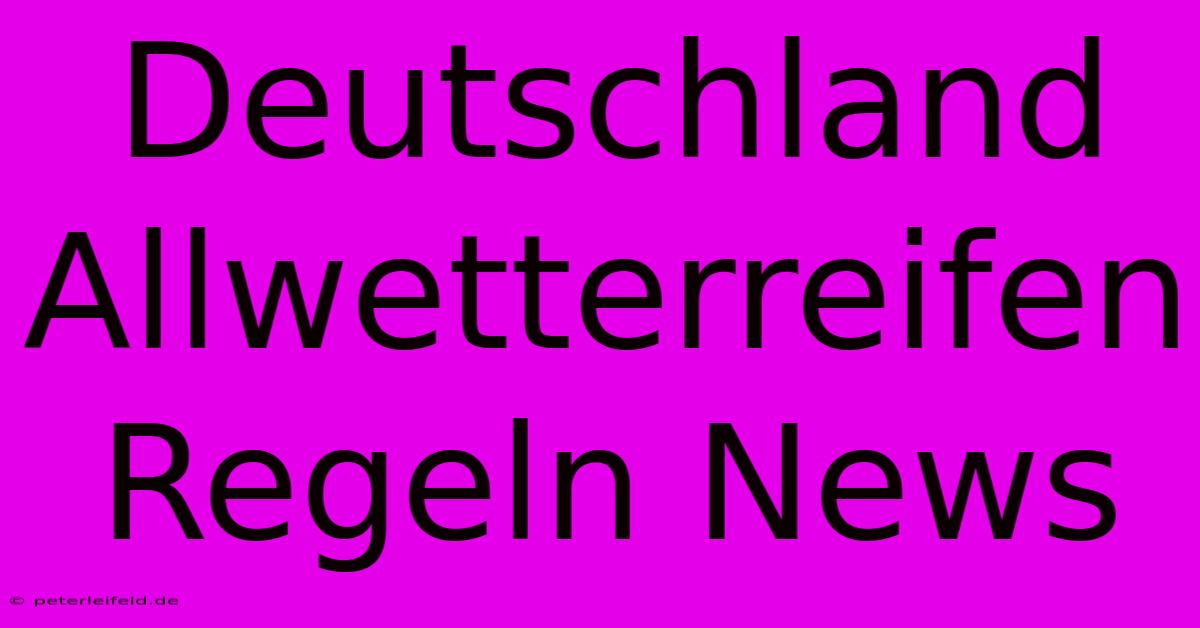Deutschland Allwetterreifen Regeln News

Discover more detailed and exciting information on our website. Click the link below to start your adventure: Visit Best Website Deutschland Allwetterreifen Regeln News. Don't miss out!
Table of Contents
Deutschland Allwetterreifen Regeln News: Was Du Wissen Musst!
Hey Leute! Let's talk Allwetterreifen in Deutschland – all-season tires, for my non-German speaking friends. This is something I've wrestled with for years, and I'm finally ready to share my hard-won wisdom (and mistakes!). Because, let's be honest, navigating German tire regulations can feel like trying to solve a Rubik's Cube blindfolded.
Meine Allwetterreifen-Odyssee: A Personal Story
So, a few years back, I was totally convinced all-season tires were the ultimate hack. One less thing to worry about, right? Wrong. I slapped a set on my old VW Golf, thinking I was a genius. Then came the first snowfall. Let's just say, I spent a very uncomfortable hour inching my way up a slight incline. It was terrifying! I learned the hard way that "all-season" doesn't mean "all-conditions."
The Harsh Reality of German Winter
See, Germany takes winter driving seriously. And for good reason – those Autobahnen can get slick in the snow and ice. While all-season tires might be okay in milder winters with light snowfall, they simply don't offer the same grip as dedicated winter tires (Winterreifen) when the going gets tough. This is especially true in areas with consistently heavy snowfall or icy conditions.
Die Regeln: What the Law Says (and Doesn't)
Now, let's get down to the legal brass tacks. There's no outright ban on all-season tires in Germany. But, and this is a big but, you're legally obligated to have tires suitable for the prevailing weather conditions. That means if there's snow or ice on the road, summer tires are a no-go. And while all-seasons might be sufficient in some situations, they aren't always going to cut it.
You might get away with it, but a hefty fine if you're caught driving on unsuitable tires during winter conditions. This could be several hundred euros! It's just not worth the risk, trust me. I've seen it happen to other drivers.
M+S vs. 3PMSF: The Symbols You Need to Know
You’ll often see tires marked with "M+S" (Mud and Snow) or the three-peak mountain snowflake symbol (3PMSF). The 3PMSF symbol is the more reliable indicator of a tire's winter performance. While M+S used to be enough, increasingly many cars require 3PMSF-marked tires for optimal safety in winter conditions. Always check your car's manual or the tire manufacturer's recommendations.
So, What's the Best Choice?
My advice? Unless you live in a region with extremely mild winters, invest in a separate set of winter tires. It's a bit more expensive upfront, but the peace of mind and increased safety are invaluable. Think of it as an insurance policy – a pretty darn cheap one considering the potential consequences of an accident. Plus, switching tires isn't as big a hassle as you might think. Many tire shops offer affordable tire storage options for the off-season.
Pro-Tip: Check the Reifenpflicht!
Before you even think about tires, check the Reifenpflicht—the specific tire requirements—for your region. Local regulations can vary depending on your location and altitude. Sometimes it's not always super easy to figure this out, but calling your local ADAC or a tire shop might make your life easier!
Remember, driving in Germany, especially during winter, is serious business. Don't cut corners on safety. Your life (and your wallet!) will thank you for it.
I hope this helped! Let me know if you have any questions – I've been through the tire wringer, so I'm happy to share my hard-won wisdom. And remember – Sicherheit zuerst! (Safety first!)

Thank you for visiting our website wich cover about Deutschland Allwetterreifen Regeln News. We hope the information provided has been useful to you. Feel free to contact us if you have any questions or need further assistance. See you next time and dont miss to bookmark.
Featured Posts
-
Notre Dame Paris Moderne Architektur
Nov 30, 2024
-
Mars Einst Feucht Vor 742 Millionen
Nov 30, 2024
-
Insiderhandel Verdacht Benko Email Hugo
Nov 30, 2024
-
Catellan Banane Justin 6 Millionen Euro
Nov 30, 2024
-
Tabellenfuehrer Admira Remis Gegen Horn
Nov 30, 2024
